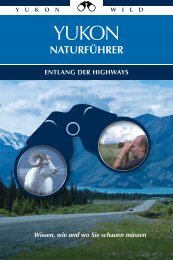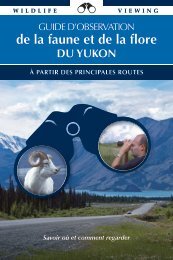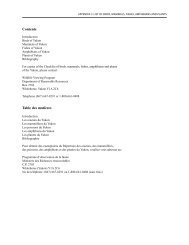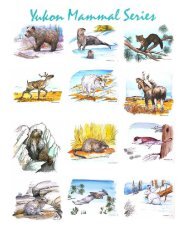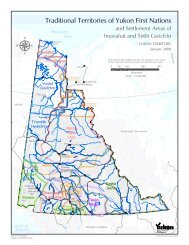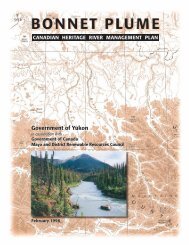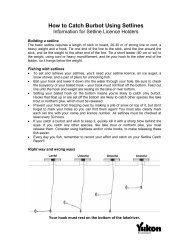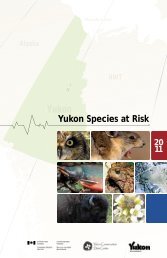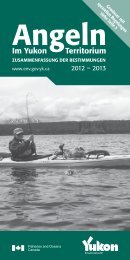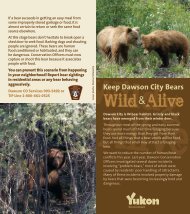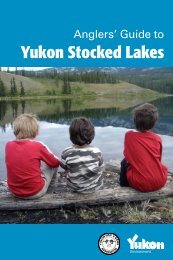Ch. 3 Land - Environment Yukon
Ch. 3 Land - Environment Yukon
Ch. 3 Land - Environment Yukon
Create successful ePaper yourself
Turn your PDF publications into a flip-book with our unique Google optimized e-Paper software.
such as the Klondike, Faro and<br />
Carmacks areas, have a higher<br />
concentration of roads. Roads crisscross<br />
these areas from lowland floodplains to<br />
high alpine tundra and open up a range<br />
of ecosystems to hunters, visitors and<br />
other prospectors long after the initial<br />
developer has left the area.<br />
Exploration<br />
In some areas in the past, exploration<br />
activity left its mark. Cat trails, all-terrain<br />
roads, trenches and stripped areas have<br />
frequently been abandoned without<br />
reclamation work. In some disturbed<br />
areas vegetation will naturally re-establish<br />
itself after five to 10 years, such as<br />
cuts and tailing piles in some placer<br />
mines in the Klondike and Mayo<br />
regions. At other sites, such as high<br />
alpine trenches excavated in rock and<br />
coarse overburden piles, hardly any<br />
vegetation growth has reappeared even<br />
after 40 years. When the ground is<br />
bare for a long period of time, processes<br />
such as erosion, slumping and permafrost<br />
degradation can occur.<br />
The new Federal Mining <strong>Land</strong> Use Regulations<br />
(MLUR) require environmental<br />
considerations. Many exploration companies<br />
have changed their operations<br />
independently of government regulations<br />
because of increased environmental<br />
awareness and improved technology.<br />
The combination of larger helicopters<br />
and lighter drilling equipment<br />
has allowed some drilling programs to<br />
leave a smaller footprint on the land.<br />
For example, when diamond drills are<br />
flown to a site, access roads are not<br />
needed. There is also a requirement<br />
for annual reports of activity to be filed<br />
during the life of the program.<br />
Excavators are now often used instead<br />
of bulldozers to dig out trenches as<br />
their smaller size makes them cheaper<br />
to move and to run. They also dig<br />
smaller trenches and can set aside the<br />
organic rich topsoil, which can be<br />
replaced on the surface of the refilled<br />
trench. These excavators can be flown to<br />
exploration sites in pieces, which again<br />
removes the need for access roads.<br />
An increasing number of exploration<br />
companies are conscious of <strong>Yukon</strong><br />
wildlife issues. Some companies will<br />
avoid sheep areas during the sensitive<br />
lambing season or caribou areas during<br />
the fall rut. Many camps now prohibit<br />
fishing and hunting.<br />
In spite of these efforts and changes in<br />
regulations, there is still a concern that<br />
exploration activities impact the pristine<br />
nature of wild lands.<br />
Mine Sites<br />
Placer and hard rock mines can affect<br />
the land by:<br />
■ disturbing vegetation and wildlife<br />
habitat and limiting other land<br />
activities such as traditional use,<br />
hunting, trapping and recreation;<br />
■ eroding of soils and slumping or<br />
creating other slope instability<br />
problems;<br />
■ disturbing streambanks and<br />
streambeds, which affects fish and<br />
wildlife habitats;<br />
■ introducing non-degradable materials,<br />
such as equipment, build-<br />
$ millions<br />
55<br />
50<br />
45<br />
40<br />
35<br />
30<br />
25<br />
20<br />
15<br />
10<br />
5<br />
0<br />
ings, mills, refuse, fuel and drilling<br />
fluids which are at times abandoned<br />
on site; and<br />
■ contaminating soils and receiving<br />
waters with improperly treated<br />
effluent or spills.<br />
Although earlier mines had limited environmental<br />
review, companies who now<br />
wish to construct a mine must go<br />
through a rigorous assessment procedure<br />
under the Canadian <strong>Environment</strong>al<br />
Assessment Act (CEAA). First, baseline<br />
studies are undertaken to collect<br />
information on the natural characteristics<br />
of the general area. These include<br />
water quality, fisheries, wildlife, vegetation<br />
and traditional land uses. Baseline<br />
studies are important because they<br />
help determine the effects an operating<br />
mine may have on the environment.<br />
New operations incorporate decommissioning<br />
planning and environmental<br />
monitoring into their proposals. Financing<br />
for abandonment is now addressed<br />
during the early stages of mine development.<br />
This Act and its enforcement<br />
are a federal responsibility as of the<br />
writing of this report, however, devolution<br />
of mining is to occur in 2001, at<br />
which time enforcement will be a<br />
<strong>Yukon</strong> responsibility.<br />
1985 1986 1987 1988 1989 1990 1991 1992 1993 1994 1995 1996 1997 1998<br />
Figure 3.9 <strong>Yukon</strong> Mineral Exploration Expenditures<br />
4 4 ❧ Y U K O N S T A T E O F T H E E N V I R O N M E N T R E P O R T 1999





